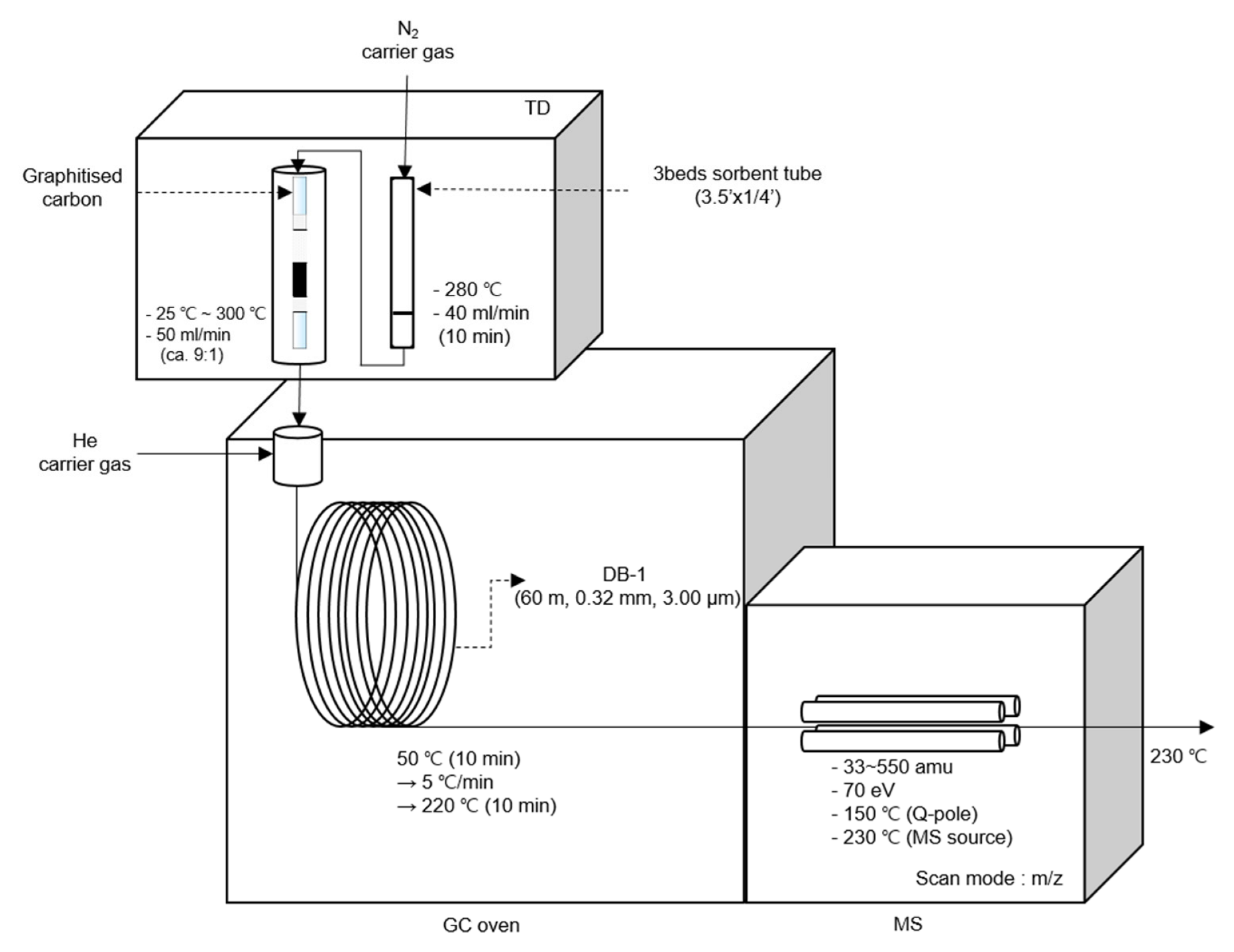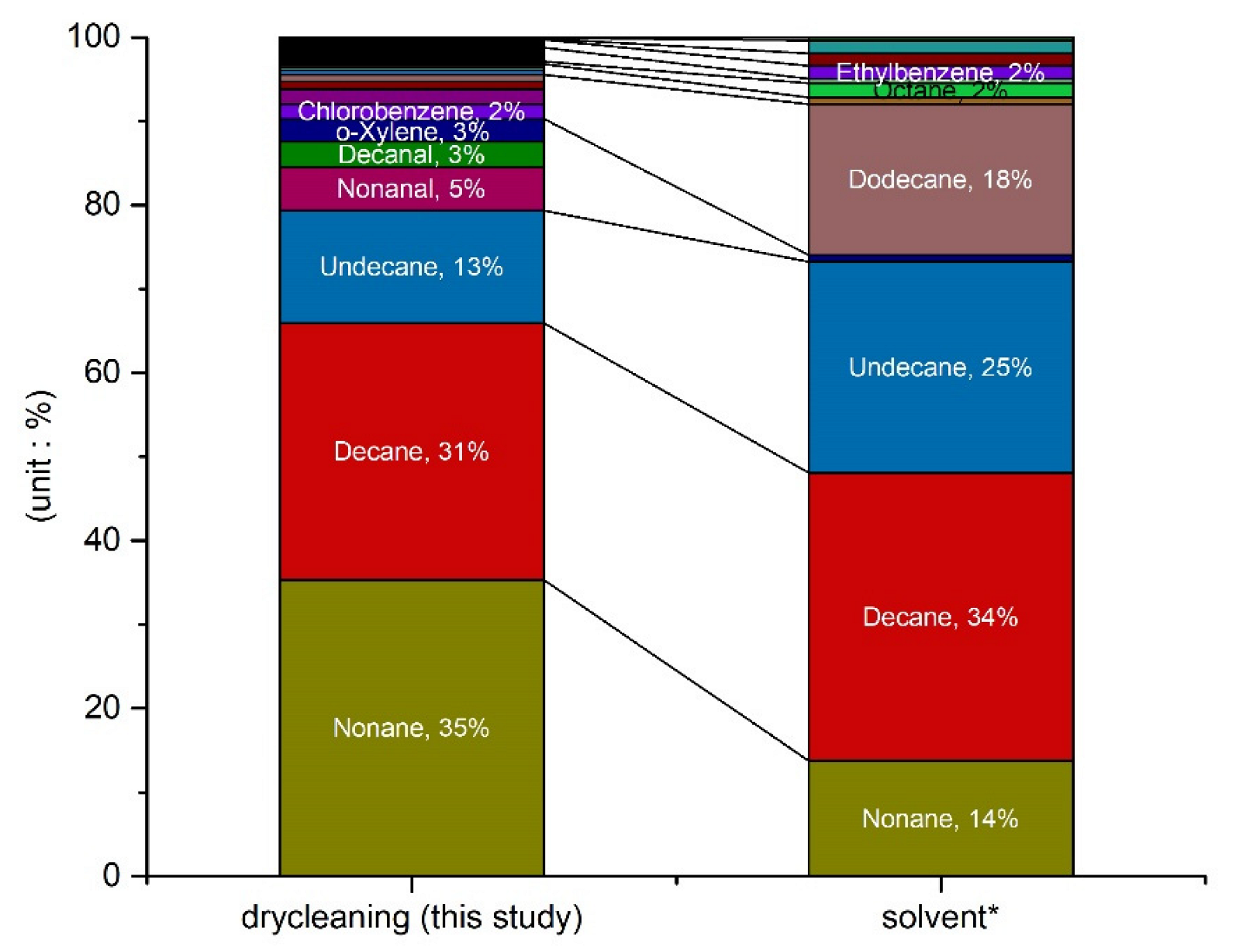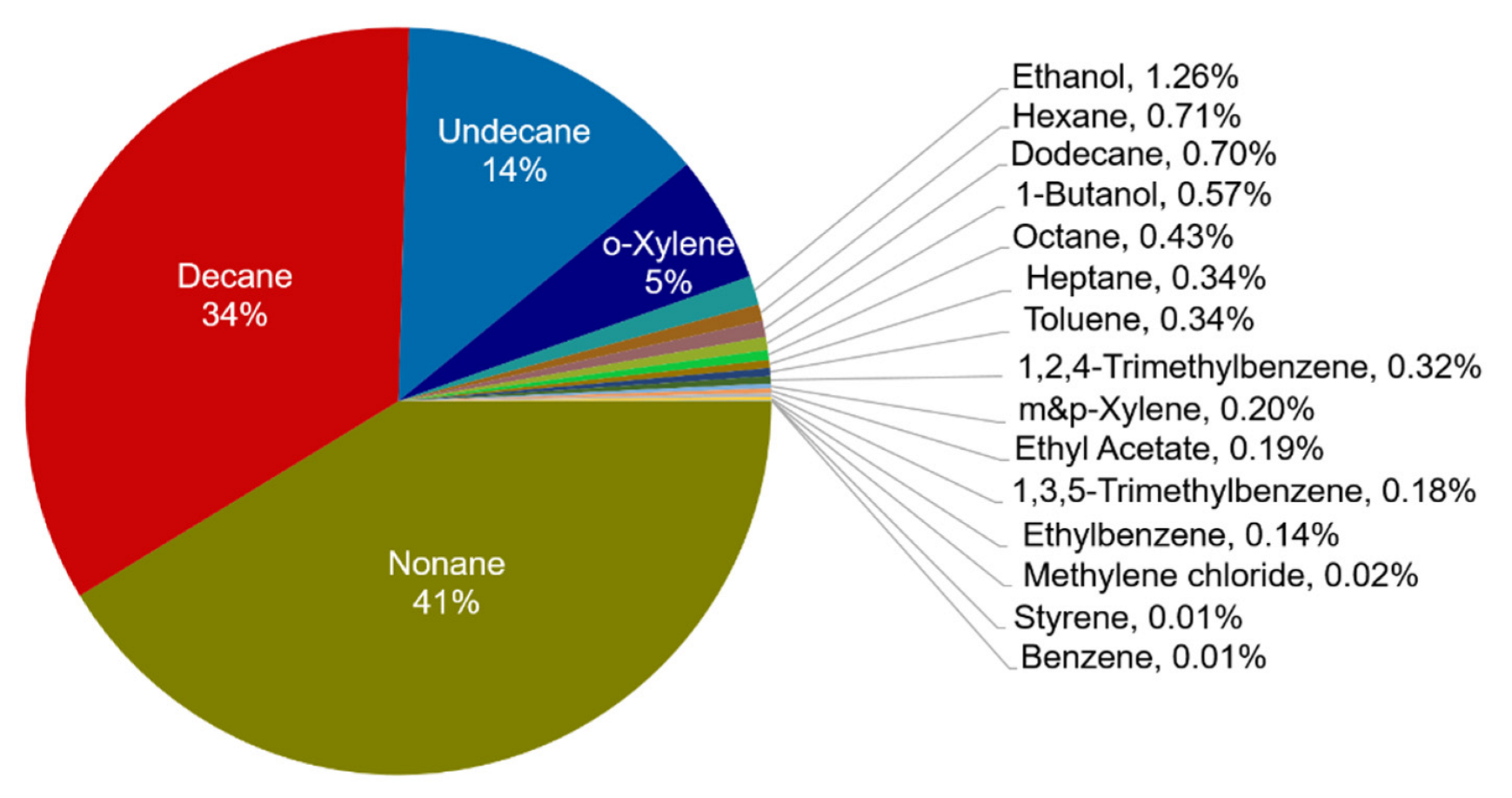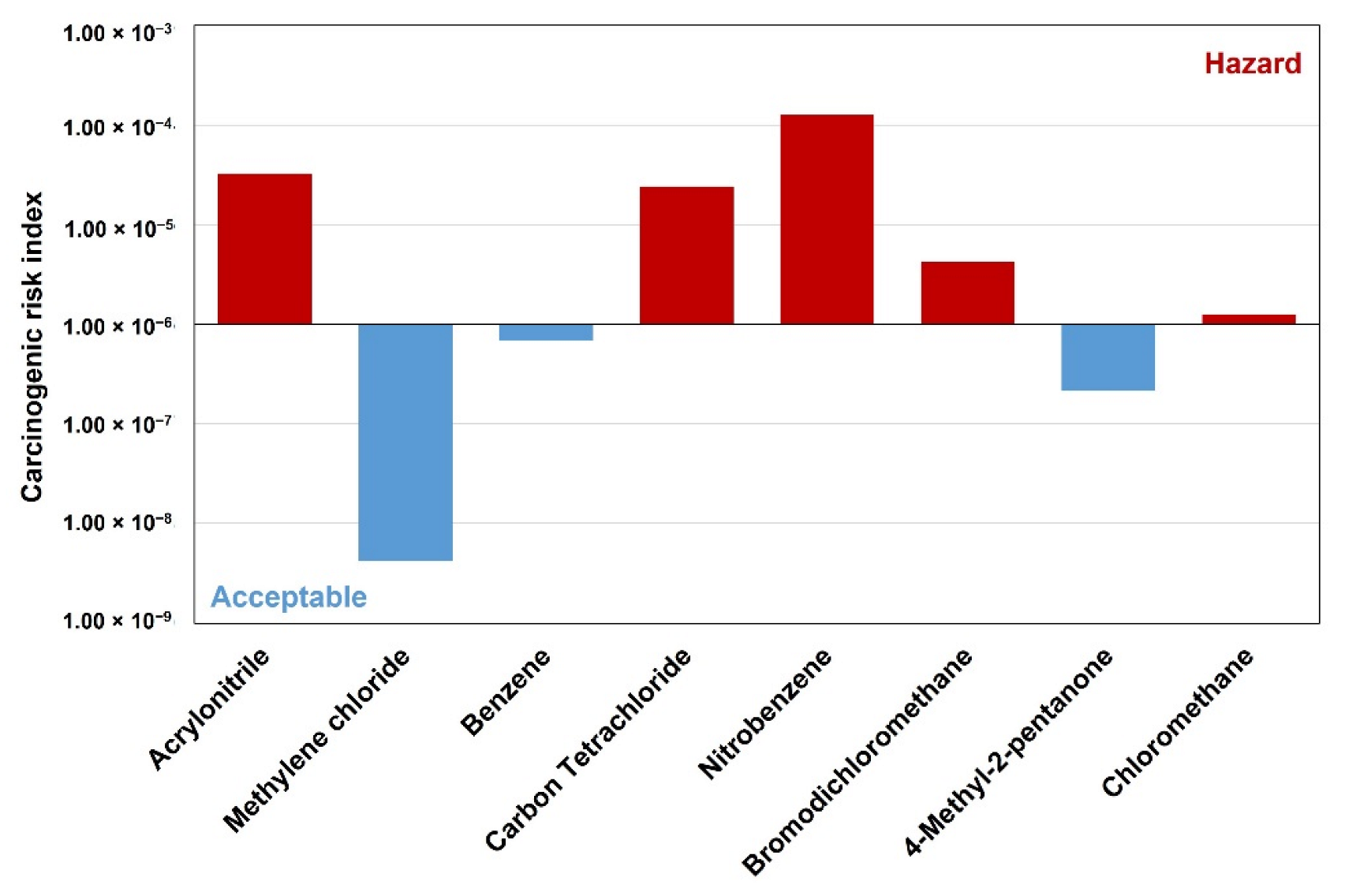Analysis of VOCs Emitted from Small Laundry Facilities: Contributions to Ozone and Secondary Aerosol Formation and Human Risk Assessment
Abstract
1. Introduction
2. Materials and Methods
2.1. VOCs Sampling and Analysis
2.2. Estimation of POCP and SOAP
2.3. Risk Assessment
3. Results and Discussion
3.1. Concentrations of VOCs during Dry Cleaning Process
3.2. Photochemical Ozone Creation Potential (POCP) and Secondary Organic Aerosol Formation Potential (SOAP) of VOCs
3.3. Risk Assessment
4. Conclusions
Supplementary Materials
Author Contributions
Funding
Institutional Review Board Statement
Informed Consent Statement
Data Availability Statement
Acknowledgments
Conflicts of Interest
References
- Kamal, M.S.; Razzak, S.A.; Hossain, M.M. Catalytic oxidation of volatile organic compounds (VOCs)—A review. Atmos. Environ. 2016, 140, 117–134. [Google Scholar] [CrossRef]
- Cetin, E.; Odabasi, M.; Seyfioglu, R. Ambient volatile organic compound (VOC) concentrations around a petrochemical complex and a petroleum refinery. Sci. Total Environ. 2003, 312, 103–112. [Google Scholar] [CrossRef]
- Onat, A. A review of fugitive emissions. Seal. Technol. 2006, 2006, 7–9. [Google Scholar] [CrossRef]
- Lin, Q.; Gao, Z.; Zhu, W.; Chen, J.; An, T. Underestimated contribution of fugitive emission to VOCs in pharmaceutical industry based on pollution characteristics, odorous activity and health risk assessment. J. Environ. Sci. 2023, 126, 722–733. [Google Scholar] [CrossRef]
- Sarkar, C.; Sinha, V.; Kumar, V.; Rupakheti, M.; Panday, A.; Mahata, K.S.; Rupakheti, D.; Kathayat, B.; Lawrence, M.G. Overview of VOC emissions and chemistry from PTR-TOF-MS measurements during the SusKat-ABC campaign: High acetaldehyde, isoprene and isocyanic acid in wintertime air of the Kathmandu Valley. Atmos. Chem. Phys. 2016, 16, 3979–4003. [Google Scholar] [CrossRef]
- Sarkar, C.; Sinha, V.; Sinha, B.; Panday, A.K.; Rupakheti, M.; Lawrence, M.G. Source apportionment of NMVOCs in the Kathmandu Valley during the SusKat-ABC international field campaign using positive matrix factorization. Atmos. Chem. Phys. 2017, 17, 8129–8156. [Google Scholar] [CrossRef]
- Stockwell, C.E.; Veres, P.R.; Williams, J.; Yokelson, R.J. Characterization of biomass burning emissions from cooking fires, peat, crop residue, and other fuels with high-resolution proton-transfer-reaction time-of-flight mass spectrometry. Atmos. Chem. Phys. 2015, 15, 845–865. [Google Scholar] [CrossRef]
- Song, M.; Kim, K.; Cho, C.; Kim, D. Reduction of volatile organic compounds (Vocs) emissions from laundry dry-cleaning by an integrated treatment process of condensation and adsorption. Processes 2021, 9, 1658. [Google Scholar] [CrossRef]
- Calvert, G.M.; Ruder, A.M.; Petersen, M.R. Mortality and end-stage renal disease incidence among dry cleaning workers. Occup. Environ. Med. 2011, 68, 709–716. [Google Scholar] [CrossRef]
- Çankaya, S.; Pekey, H.; Pekey, B.; Özerkan Aydın, B. Volatile organic compound concentrations and their health risks in various workplace microenvironments. Hum. Ecol. Risk Assess. 2020, 68, 709–716. [Google Scholar] [CrossRef]
- Ceballos, D.M.; Fellows, K.M.; Evans, A.E.; Janulewicz, P.A.; Lee, E.G.; Whittaker, S.G. Perchloroethylene and Dry Cleaning: It’s Time to Move the Industry to Safer Alternatives. Front. Public Health 2021, 9, 638082. [Google Scholar] [CrossRef] [PubMed]
- Kim, J.H.; Yoo, K.S. Study on the enhancement of VOCs management at laundry facilities in Korea. J. Environ. Policy Adm. 2017, 25, 139–171. [Google Scholar] [CrossRef]
- McDonald, B.C.; De Gouw, J.A.; Gilman, J.B.; Jathar, S.H.; Akherati, A.; Cappa, C.D.; Jimenez, J.L.; Lee-Taylor, J.; Hayes, P.L.; McKeen, S.A.; et al. Volatile chemical products emerging as largest petrochemical source of urban organic emissions. Science 2018, 359, 760–764. [Google Scholar] [CrossRef] [PubMed]
- Niu, Z.; Kong, S.; Zheng, H.; Yan, Q.; Liu, J.; Feng, Y.; Wu, J.; Zheng, S.; Zeng, X.; Yao, L.; et al. Temperature dependence of source profiles for volatile organic compounds from typical volatile emission sources. Sci. Total Environ. 2021, 751, 141741. [Google Scholar] [CrossRef] [PubMed]
- Park, O.-H.; Lee, K.-S.; Min, K.-W.; Cho, G.; Yoon, K.-J.; Jeong, W.-S.; Cho, Y.-G.; Kim, E.-S.; Yang, J.-S. Generating characteristics of VOCs in a commercial laundry shop and the effects on the health of workers. J. Korean Soc. Occup. Environ. Hyg. 2016, 26, 159–169. [Google Scholar] [CrossRef][Green Version]
- Liu, H.; Liu, S.; Xue, B.; Lv, Z.; Meng, Z.; Yang, X.; Xue, T.; Yu, Q.; He, K. Ground-level ozone pollution and its health impacts in China. Atmos. Environ. 2018, 173, 223–230. [Google Scholar] [CrossRef]
- Lu, X.; Hong, J.; Zhang, L.; Cooper, O.R.; Schultz, M.G.; Xu, X.; Wang, T.; Gao, M.; Zhao, Y.; Zhang, Y. Severe surface ozone pollution in China: A global perspective. Environ. Sci. Technol. Lett. 2018, 5, 487–494. [Google Scholar] [CrossRef]
- Faust, J.A.; Wong, J.P.; Lee, A.K.; Abbatt, J.P. Role of Aerosol Liquid Water in Secondary Organic Aerosol Formation from Volatile Organic Compounds. Environ. Sci. Technol. 2017, 51, 1405–1413. [Google Scholar] [CrossRef]
- Kroll, J.H.; Seinfeld, J.H. Chemistry of secondary organic aerosol: Formation and evolution of low-volatility organics in the atmosphere. Atmos. Environ. 2008, 42, 3593–3624. [Google Scholar] [CrossRef]
- Ziemann, P.J.; Atkinson, R. Kinetics, products, and mechanisms of secondary organic aerosol formation. Chem. Soc. Rev. 2012, 41, 6582–6605. [Google Scholar] [CrossRef]
- Fine, P.M.; Sioutas, C.; Solomon, P.A. Secondary particulate matter in the United States: Insights from the particulate matter supersites program and related studies. J. Air Waste Manag. Assoc. 2008, 58, 234–253. [Google Scholar] [CrossRef] [PubMed]
- Whalley, L.K.; Slater, E.J.; Woodward-Massey, R.; Ye, C.; Lee, J.D.; Squires, F.; Hopkins, J.R.; Dunmore, R.E.; Shaw, M.; Hamilton, J.F.; et al. Evaluating the sensitivity of radical chemistry and ozone formation to ambient VOCs and NOx in Beijing. Atmos. Chem. Phys. 2021, 21, 2125–2147. [Google Scholar] [CrossRef]
- Berezina, E.; Moiseenko, K.; Skorokhod, A.; Pankratova, N.V.; Belikov, I.; Belousov, V.; Elansky, N.F. Impact of VOCs and NOx on Ozone Formation in Moscow. Atmosphere 2020, 11, 1262. [Google Scholar] [CrossRef]
- Alvim, D.S.; Gatti, L.V.; Corrêa, S.M.; Chiquetto, J.B.; Santos, G.M.; de Souza Rossatti, C.; Pretto, A.; Rozante, J.R.; Figueroa, S.N.; Pendharkar, J.; et al. Determining VOCs Reactivity for Ozone Forming Potential in the Megacity of São Paulo. Aerosol Air Qual. Res. 2018, 18, 2460–2474. [Google Scholar] [CrossRef]
- Lee, H.; Kim, K.; Choi, Y.; Kim, D. Emissions of volatile organic compounds (Vocs) from an open-circuit dry cleaning machine using a petroleum-baseorganic solvent: Implications for impacts on air quality. Atmosphere 2021, 12, 637. [Google Scholar] [CrossRef]
- Bidila, T.; Pietraru, R.N.; Ionita, A.D.; Olteanu, A. Monitor indoor air quality to assess the risk of COVID-19 transmission. In Proceedings of the 2021 23rd International Conference on Control Systems and Computer Science Technologies, CSCS 2021, Bucharest, Romania, 26–28 May 2021. [Google Scholar]
- Rani, R.; Arokiasamy, P.; Sikarwar, A. Household air pollution during COVID-19 pandemic: A concern in India. J. Public Aff. 2021, 21, e2729. [Google Scholar] [CrossRef]
- European Comission. Indoor Air Pollution: New EU Research Reveals Higher Risks than Previously Thought; European Commission: Brussels, Belgium, 2003. [Google Scholar]
- Johnson, M.M.; Williams, R.; Fan, Z.; Lin, L.; Hudgens, E.; Gallagher, J.; Vette, A.; Neas, L.; Özkaynak, H. Participant-based monitoring of indoor and outdoor nitrogen dioxide, volatile organic compounds, and polycyclic aromatic hydrocarbons among MICA-Air households. Atmos. Environ. 2010, 44, 4927–4936. [Google Scholar] [CrossRef]
- Villanueva, F.; Tapia, A.; Lara, S.; Amo-Salas, M. Indoor and outdoor air concentrations of volatile organic compounds and NO2 in schools of urban, industrial and rural areas in Central-Southern Spain. Sci. Total Environ. 2018, 622–623, 222–235. [Google Scholar] [CrossRef]
- WHO. Burden of Disease from the Joint Effects of Household and Ambient Air Pollution for 2012; WHO: Geneva, Switzerland, 2012. [Google Scholar]
- Guo, H.; Lee, S.C.; Chan, L.Y.; Li, W.M. Risk assessment of exposure to volatile organic compounds in different indoor environments. Environ. Res. 2004, 94, 57–66. [Google Scholar] [CrossRef]
- KOSIS. 2021. Available online: https://kosis.kr/statHtml/statHtml.do?orgId=101&tblId=DT_1KB9001&conn_path=I2 (accessed on 6 September 2022).
- Kim, S.; Han, J.; Kim, H. A Study on the source profile of volatile organic compounds from major emission sources. J. Korean Soc. Atmos. Environ. 2001, 17, 233–240, (In Korean with English abstract). [Google Scholar]
- Garzón, J.P.; Huertas, J.I.; Magaña, M.; Huertas, M.E.; Cárdenas, B.; Watanabe, T.; Maeda, T.; Wakamatsu, S.; Blanco, S. Volatile organic compounds in the atmosphere of Mexico City. Atmos. Environ. 2015, 119, 415–429. [Google Scholar] [CrossRef]
- Lam, S.H.M.; Saunders, S.M.; Cheng, H.R.; Guo, H. Examination of regional ozone formation: POCPs for Western Australia and comparisons to other continents. Environ. Model. Softw. 2015, 74, 194–200. [Google Scholar] [CrossRef]
- Derwent, R.G.; Jenkin, M.E.; Passant, N.R.; Pilling, M.J. Reactivity-based strategies for photochemical ozone control in Europe. Environ. Sci. Policy 2007, 10, 445–453. [Google Scholar] [CrossRef]
- Derwent, R.G.; Jenkin, M.E.; Utembe, S.R.; Shallcross, D.E.; Murrells, T.P.; Passant, N.R. Secondary organic aerosol formation from a large number of reactive man-made organic compounds. Sci. Total Environ. 2010, 408, 3374–3381. [Google Scholar] [CrossRef]
- USEPA. Guideline for Human Exposure Assessment; United States Environmental Protection Agency: Washington, DC, USA, 2019.
- Barr, D.B.; Thomas, K.; Curwin, B.; Landsittel, D.; Raymer, J.; Lu, C.; Donnelly, K.C.; Acquavella, J. Biomonitoring of exposure in farmworker studies. Environ. Health Perspect. 2006, 114, 936–942. [Google Scholar] [CrossRef] [PubMed]
- USEPA. Guidelines for Carcinogen Risk Assessment—EPA/630/P-03/001B; United States Environmental Protection Agency: Washington, DC, USA, 2005.
- DeLeo, P.C.; Ciarlo, M.; Pacelli, C.; Greggs, W.; Williams, E.S.; Scott, W.C.; Wang, Z.; Brooks, B.W. Cleaning product ingredient safety: What is the current state of availability of information regarding ingredients in products and their function? ACS Sustain. Chem. Eng. 2018, 6, 2094–2102. [Google Scholar] [CrossRef]
- Salhotra, A.M. Human health risk assessment for contaminated properties. Prog. Mol. Biol. Transl. Sci. 2012, 112, 285–306. [Google Scholar]
- USEPA. Integrated Risk Information System (IRIS) Glossary. 2022. Available online: https://sor.epa.gov/sor_internet/registry/termreg/searchandretrieve/glossariesandkeywordlists/search.do?details=&glossaryName=IRIS%20Glossary (accessed on 27 September 2022).
- You, S.-J.; Choi, J.-W.; Kim, Y.-T. The Health Risk Assessment of Ambient VOCs in Busan Industrial Area; The Annual Report of Busan Metropolitan city Institute of Health & Environment: Busan, Republic of Korea, 2012. (In Korean) [Google Scholar]
- USEPA. Risk Assessment Guidance for Superfund (RAGS) Volume III—Part A: Process for Conducting Probabilistic Risk Assessment, Appendix B; United States Environmental Protection Agency: Washington, DC, USA, 2001.
- Lee, T.J.; Lee, S.M.; Chae, J.S.; Jeon, J.M.; Kim, D.S.; Jo, Y.M. Inventory of ozone precursor VOCs from organic solvents used in residential workplaces and assessment of ozone formation contribution. J. Korean Soc. Atmos. Environ. 2021, 37, 102–112. [Google Scholar] [CrossRef]
- Vega, E.; Mugica, V.; Carmona, R.; Valencia, E. Hydrocarbon source apportionment in Mexico City using the chemical mass balance receptor model. Atmos. Environ. 2000, 34, 4121–4129. [Google Scholar] [CrossRef]
- Scheff, P.A.; Wadden, R.A.; Bates, B.A.; Aronian, P.F. Source fingerprints for receptor modeling of volatile organics. J. Air Pollut. Control Assoc. 1989, 39, 469–478. [Google Scholar] [CrossRef]
- Achimón, F.; Brito, V.D.; Pizzolitto, R.P.; Zygadlo, J.A. Effect of carbon sources on the production of volatile organic compounds by fusarium verticillioides. J. Fungi 2022, 8, 158. [Google Scholar] [CrossRef] [PubMed]
- Wang, J.Z.; Hou, Y.; Zhang, J.; Zhu, J.; Feng, Y.L. Transformation of 2,2’,4,4’-tetrabromodiphenyl ether under UV irradiation: Potential sources of the secondary pollutants. J. Hazard. Mater. 2013, 263, 778–783. [Google Scholar] [CrossRef] [PubMed]
- Palmisani, J.; Nørgaard, A.W.; Kofoed-Sørensen, V.; Clausen, P.A.; de Gennaro, G.; Wolkoff, P. Formation of ozone-initiated VOCs and secondary organic aerosol following application of a carpet deodorizer. Atmos. Environ. 2020, 222, 117149. [Google Scholar] [CrossRef]
- Omrane, F.; Khadhraoui, M.; Abid, A.; Mitigui, M.; Elleuch, B.; Gargouri, I. Health risk assessment of occupational exposure to perchloroethylene and trichloroethylene in dry cleaning in Sfax city (Tunisia). In Environmental Science and Engineering; Springer: Berlin/Heidelberg, Germany, 2021. [Google Scholar]






| No. | Compound | CAS NO. | IARC WOE * | EPA WOE ** | Unit Risk (µg/m3)−1 | Inhalation Slope Factor (mg/kg·day)−1 | Reference |
|---|---|---|---|---|---|---|---|
| 1 | Acrylonitrile | 107-13-1 | 2B | B1 | 6.80 × 10−5 | 2.38 × 10−1 | EPA IRIS |
| 2 | Methylene chloride | 75-09-2 | 2A | LH | 1.00 × 10−8 | 3.50 × 10−5 | EPA IRIS |
| 3 | Benzene | 71-43-2 | 1 | CH | 7.80 × 10−6 | 2.73 × 10−2 | EPA IRIS |
| 4 | Carbon Tetrachloride | 56-23-5 | 2B | LH | 1.50 × 10−5 | 1.30 × 10−1 | EPA IRIS |
| 5 | Nitrobenzene | 98-95-3 | 2B | LH | 4.00 × 10−5 | 1.40 × 10−1 | EPA IRIS |
| 6 | Bromodichloromethane | 75-27-4 | 2B | - | 1.77 × 10−5 | 6.20 × 10−2 | MDEQ |
| 7 | 4-Methyl-2-pentanone | 108-10-1 | 2B | lnl | 4.94 × 10−7 | 1.73 × 10−3 | MDEQ |
| 8 | Chloromethane | 74-87-3 | 3 | lnl | 1.80 × 10−6 | 6.30 × 10−3 | HEAST, MDEQ |
| No. | Compound | CAS NO. | RfD * (mg/kg·day) | RfC ** (mg/m3) | Reference |
|---|---|---|---|---|---|
| 1 | Bromomethane | 74-83-9 | 1.40 × 10−3 | 5.00 × 10−3 | EPA IRIS |
| 2 | Toluene | 108-88-3 | 8.00 × 10−2 | 5.00 × 100 | EPA IRIS |
| 3 | Chlorobenzene | 108-90-7 | 2.00 × 10−2 | 7.00 × 10−2 | EPA IRIS |
| 4 | m&p-Xylene | 1330-20-7 | 2.00 × 10−1 | 1.00 × 10−1 | EPA IRIS |
| 5 | o-xylene | 1330-20-7 | 2.00 × 10−1 | 1.00 × 10−1 | EPA IRIS |
| 6 | 1,3-Dichlorobenzene | 541-73-1 | 2.00 × 10−3 | 7.00 × 10−3 | ATSDR, MDEQ |
| 7 | 1,2,4-Trichlorobenzene | 120-82-1 | 1.00 × 10−2 | 3.50 × 10−2 | EPA IRIS |
| 8 | Hexachloro-1,3-Butadiene | 87-68-3 | 1.00 × 10−3 | 3.50 × 10−3 | PPRTV |
| 9 | Ethanol | 64-17-5 | 6.20 × 101 | 2.17 × 102 | MDEQ |
| 10 | Hexane | 110-54-3 | - | 7.00 × 10−1 | EPA IRIS |
| 11 | Ethylbenzene | 100-41-4 | 1.00 × 10−1 | 1.00 × 101 | EPA IRIS |
Publisher’s Note: MDPI stays neutral with regard to jurisdictional claims in published maps and institutional affiliations. |
© 2022 by the authors. Licensee MDPI, Basel, Switzerland. This article is an open access article distributed under the terms and conditions of the Creative Commons Attribution (CC BY) license (https://creativecommons.org/licenses/by/4.0/).
Share and Cite
Eun, D.-M.; Han, Y.-S.; Park, S.-H.; Yoo, H.-S.; Le, Y.T.-H.; Jeong, S.; Jeon, K.-J.; Youn, J.-S. Analysis of VOCs Emitted from Small Laundry Facilities: Contributions to Ozone and Secondary Aerosol Formation and Human Risk Assessment. Int. J. Environ. Res. Public Health 2022, 19, 15130. https://doi.org/10.3390/ijerph192215130
Eun D-M, Han Y-S, Park S-H, Yoo H-S, Le YT-H, Jeong S, Jeon K-J, Youn J-S. Analysis of VOCs Emitted from Small Laundry Facilities: Contributions to Ozone and Secondary Aerosol Formation and Human Risk Assessment. International Journal of Environmental Research and Public Health. 2022; 19(22):15130. https://doi.org/10.3390/ijerph192215130
Chicago/Turabian StyleEun, Da-Mee, Yun-Sung Han, Soo-Hyun Park, Hwa-Seong Yoo, Yen Thi-Hoang Le, Sangmin Jeong, Ki-Joon Jeon, and Jong-Sang Youn. 2022. "Analysis of VOCs Emitted from Small Laundry Facilities: Contributions to Ozone and Secondary Aerosol Formation and Human Risk Assessment" International Journal of Environmental Research and Public Health 19, no. 22: 15130. https://doi.org/10.3390/ijerph192215130
APA StyleEun, D.-M., Han, Y.-S., Park, S.-H., Yoo, H.-S., Le, Y. T.-H., Jeong, S., Jeon, K.-J., & Youn, J.-S. (2022). Analysis of VOCs Emitted from Small Laundry Facilities: Contributions to Ozone and Secondary Aerosol Formation and Human Risk Assessment. International Journal of Environmental Research and Public Health, 19(22), 15130. https://doi.org/10.3390/ijerph192215130







